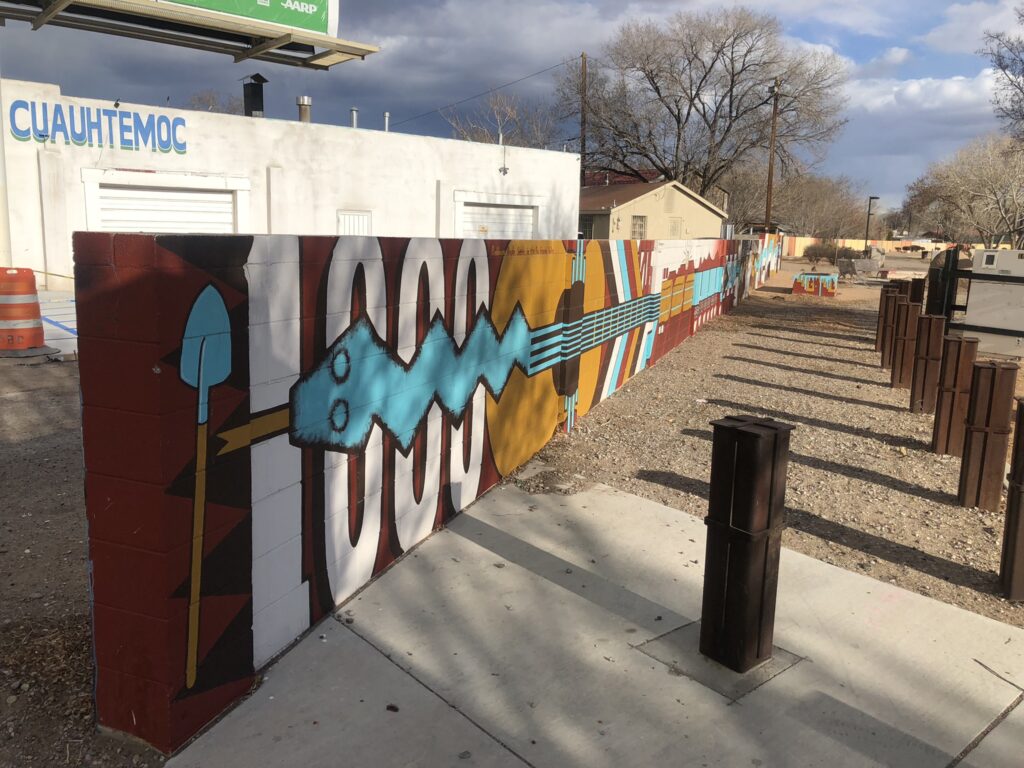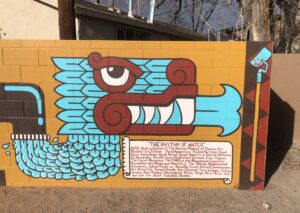
The Rhythm of Water, a 2013 mural by Eric J. Garcia and a ton of other folks, Atrisco (Albuquerque), New Mexico
tl;dr – We’ve got a bunch of really interesting interdisciplinary work underway at the University of New Mexico’s Water Resources Program. If you know someone finishing their undergraduate work or early in their career, interested in water work beyond the solely sciency/engineering paths, send them our way!
longer

water as art, art as water
It’s weird, but now that I’m no longer the director of the University of New Mexico Water Resources Program, I actually have more time to think about the academic and intellectual task of water management.
And, for a variety of reasons, I’ve been thinking a lot about the task of interdisciplinarity in water management.
The biggest reason is a pretty intense ongoing conversation with one of our students who’s just finishing up their degree, and who has started working for a very progressive water agency that understands that the task of managing water extends far beyond the physical science and technical questions involved.
In my transition to work at the Utton Center, a natural resource group at the UNM School of Law, I’m continuing to work with a bunch of Water Resources Program students, and I’ll still be teaching the fall introductory course with my colleague and collaborator Bob Berrens.
My new life, shorn of administrative responsibilities, gives me more time to think about this stuff, and engage in the deeper conversations with our students that are the most treasured part of the gig. Bob and I seem to have inadvertently assembled a critical mass of really talented students helping us think about the core question we pose in our fall course:
There’s less water. What do we do?
This is not solely, or even primarily, a technical question.
In an interview earlier this month in Vox, geographer Edward Carr said this:
There are going to be certain situations we can’t just throw money at or build infrastructure for. We’re going to have to make decisions about what we want to preserve and what we’re willing to give away, what’s essential to us, and what do we keep? That’s a social choice and that’s a political choice. Our political systems, the way that we interact with each other, and the way that we identify problems and solutions — all of that becomes central to how we will function in the face of climate change.
The stuff our students are working on now is super exciting:
- Tax policy (who knew tax policy had such important implications for how we use irrigation water in New Mexico? Stay tuned, much more on this soon….)
- The benefits and costs and implications of water use transfers from rural irrigation to municipal use
- The environmental and cultural implications of land fallowing – whether because of transfers, or because the water just ain’t there
- Some unexpected agricultural crop-shifting responses to climate change
- The community and cultural value of non-commercial irrigation (and the risks to these values posed by climate change)
- A re-evaluation of ecosystem goods and services of the Rio Grande and the irrigation systems around the river here in central New Mexico
Some of this is funded through UNM’s participation in the South Central Climate Adaptation Center, some of it’s now supported through my work at Utton, and some of it’s just the stuff that we do as part of the degree-granting process.
Underpinning all of this is a recognition that “water management” is not solely a technical question, to be left to engineers and physical scientists, and is why I so treasure the interdisciplinary nature of the Water Resources Program.
If you know some bright young person interested in an interdisciplinary perspective on water management, encourage them to contact me. I’m no longer the director, but I can talk about the stuff our group is working on, and connect them with the current program leadership.

Have your students looked at other systems, especially Israel, to see their innovations and policies? We don’t have to reinvent the wheel.
Growing hay for livestock may be a thing of the past. Perhaps row crops that can be drip irrigated. No till.
Indigenous methods must be considered. Foods grown could change in that direction. They were adapted to our arid regions for 1000s of years successfully.
“Because we have always done it this way” is not a path forward. New Mexico is considered by many to be one of the most beautiful states in our union. But we are not suitable for farming. Wasting precious water resources on low GDP yielding crops is a mismanagement of resources. And I hear of several who flood grassy fields just to retain their water allocation. We don’t have a water shortage problem: We have a water mismanagement problem.
Fleck, it sounds like you’re having even more fun than ever at UNM. Administrative leadership has its rewards in enabling others, but what I learned in that position is that “leading a community of scholars” is a phrase with three errors in it. Nothing beats doing your own teaching and research with a bunch of brilliant grad students.
BTW, do you have an estimated publication date for your next book?
In response to Tom above, how do you know that a farmer is wasting water? I work in western water, and really dislike the way agriculture is characterized. Some questions;
1. What do you know about a given ditch or canal system? Do you know how it’s organized, how many outstanding shares there may be, and how many a farmer may hold?
2. Do you know what the yield per share in dry year, average, and wet year conditions is?
3. What about consumptive use and return flow percentages? How much makes it back to the stream, and what is the crop irrigation requirement?
The farmers I know are completely at the mercy of hydrology in surface irrigation systems. Well users may be more profligate, but the smart ones aren’t, and water use is a function of how water is being allocated to them. They can waste it if they’re allowed to-smart water managers won’t allow them to.
No one asked the urban residents of the West to come here. Denver and Colorado Springs and ABQ and all the rest are far more artificial constructs in this landscape than farming is. These issues are incredibly complex and nuanced, and a person does way to approach this subject with immense humility.
Thank you for your heartfelt comments. Maybe “wasting water” is too harsh of an assessment; “enormous consumption” may be a better descriptor. “Because it has always been done this way” is not a path forward. Our ancestors evolved, invented, created and adapted. Our climate changes are forcing us to do the same.
Everyone in water restricted areas paying the going rate for water will help us allocate water more efficiently and to best use. Of course there will be exceptions and greed will cause inefficiencies, but for the most part, water exchanges can help control abuses.
I have land that is mine and the city of ABQ took it from me so they could store water on it. The same actions will also eventually happen to all water rights in the SW, if we all don’t start using water efficiently right now.
Tom, same to you, thanks.
This comment from Burkholder (1928) jumps out at me:
“There is some evidence to support the theory that there has been a climatic change in the Southwestern part of the United States, and that the rainfall and streamflow is less now than it once was.”.
Irrigation methods are an important conversation to have. In my line of work, when we assign what are called “presumptive depletion factors” or “wellhead depletion factors” to well pumping, you can starkly see the difference in irrigation methods. Sole-source flood irrigation using well water takes a PDF/WHD of 0.5, and using well water to supplement surface rights takes 0.36. Sprinklers take 0.75, and drip, 1.0. What this means is that if a farmer needs 100 acre-feet to get his field to harvest and he’s using a pivot, we would allocate him 100/0.75 = 133.3 acre-feet vs. sole-source well, where 100/0.5 = 200 acre-feet of water. Theoretically, a drip system is perfectly efficient (it’s not) and every unit of water allocated is consumptively used and no more than what is required need be allocated.
There is tremendous uncertainty in the hydrologic systems of the West, even now with both larger data sets and better measurement tools than those of a century ago. We still don’t seem to utilize however whatever understanding we have of the temporal and spatial distribution of water in ways that really lead to meaningful changes in water management. I think this due to poor communication, for all the talking about water done these days, and a total lack of unifying values around how water should be used and what we value.
I for one love irrigated lands with great big cottonwoods blowing in the wind after a hot summer’s day, away from large metropolitan centers. I think that agriculture uses a lot of water, true, but that its value goes beyond the commerical and economic indices so often used as the measure of all things in the United States. Growing up, nothing was better on a cool night than the smell of fresh cut alfalfa. The old men and women I knew in my youth that had farmed all their lives gave that area a unique character that has shaped me and all that I value to this day. We in this country would do well by ourselves and our descendants to ask ourselves, what is it that we really want?